
Concept explainers
Two small disks A and B of mass 2 kg and 1 kg, respectively, may slide on a horizontal and frictionless surface. They are connected by a cord of negligible mass and spin about their mass center G. At t = 0, G is moving with the velocity

(a)
The initial velocity,
Answer to Problem 14.54P
Explanation of Solution
Given information:
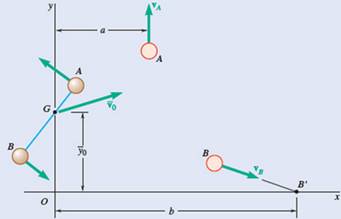
Mass of the disk A,
Mass of the disk B,
At t=0,
Co-ordinates of G are
Velocity of A,
Velocity,
Distance
Firstly, calculate for initial condition:
The free body diagram for initial condition is as follows:
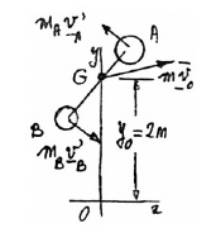
The distance G from points A and B,
And,
Now, considering linear momentum,
Hence, angular momentum of both the disc about G,
Now, kinetic energy of the component is,
Calculation:
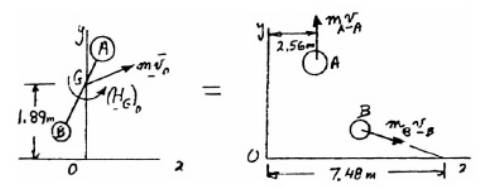
Using conservation of mass of linear momentum,
(b)
The length of cord initially connecting the two disks.
Answer to Problem 14.54P
Explanation of Solution
Given information:
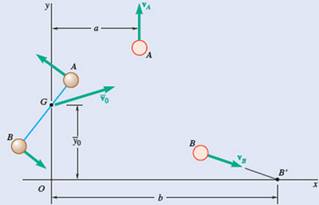
Mass of the disk A,
Mass of the disk B,
At t=0,
Co-ordinates of G are
Velocity of A,
Velocity,
Distance
Firstly, calculate for initial condition:
The free body diagram for initial condition is as follows:

The distance G from points A and B,
And,
Now, considering linear momentum,
Hence, angular momentum of both the disc about G,
Now, kinetic energy of the component is,
Calculation:
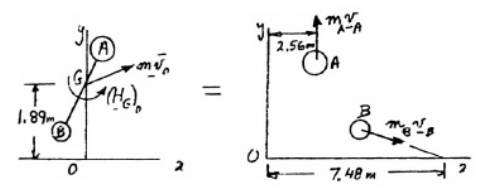
Using conservation of mass of linear momentum,
Conservation of angular momentum of both the disc about point O,
Now, applying law of conservation of energy:
Dividing equation (2) by equation (1);
Now, substituting the value of ? in equation (1);
(c)
The rate in rad/s at which the disks were spinning about G.
Answer to Problem 14.54P
Explanation of Solution
Given information:
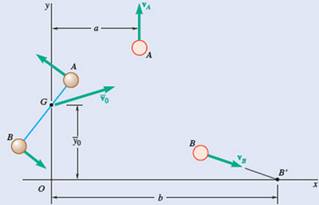
Mass of the disk A,
Mass of the disk B,
At t=0,
Co-ordinates of G are
Velocity of A,
Velocity,
Distance
Firstly, calculate for initial condition:
The free body diagram for initial condition is as follows:

The distance G from points A and B,
And,
Now, considering linear momentum,
Hence, angular momentum of both the disc about G,
Now, kinetic energy of the component is,
Calculation:
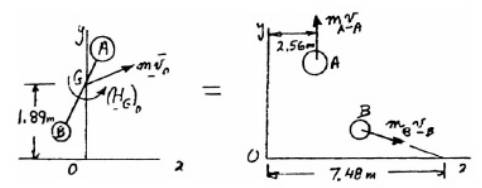
Using conservation of mass of linear momentum,
Conservation of angular momentum of both the disc about point O,
Now, applying law of conservation of energy:
Dividing equation (2) by equation (1);
Want to see more full solutions like this?
Chapter 14 Solutions
Vector Mechanics For Engineers
- A hoop of radius 95mm and mass 100g is rotated via a capacitor driven power source with P(t)=1.61e-1.3tW. (since it is a hoop, it is a special case, and r=rG) Assuming the hoop is accelerated from rest, determine the rotational velocity after t=8.5s. [rad.s-1] Determine the rotational speed of the hoop after t=8.5s if the power source acts to roll the particle from rest on a horizontal surface. [rad.s-1]arrow_forwardCalculate the kinetic energy loss in a perfectly inelastic collision between an object of mass 40kg with velocity 8m/s and an object of mass 60kg coming in the opposite direction with velocity 2m/s.arrow_forwardThe figure shows a small piece of clay colliding into a disk. The disk is initially at rest, but can rotate about a pivot fixed at its center. The collision is completely inelastic.The disk has mass M = 4.73 kilograms and radius R = 0.755 meters. The clay has mass m = 279 grams and is moving horizontally at vi = 3.66 m/s just before colliding with and sticking to the disk. The clay strikes the edge of the disk at a location of b = 0.505 meters offset from the center of the disk. Note that the size of the clay is negligible compared to the radius of the disk. Calculate the angular velocity (rad/s) of the disk just after the collision.arrow_forward
- Two identical giant flywheels are on 2 identical slopes at an angle alpha = 20 deg. One flywheel is rolling on its inside shaft of diameter d1 = 3 ft, and the second flywheel is rolling without slipping on its outside diameter d2 = 5 ft. They are both released from rest. The weight of the flywheel is W = 8 lbs 1. Knowing that flywheel 1 attains a speed of v = 7.0 ft/s in t = [t] s, (if t doesn't show take any t between 5 and 10 sec) find the radius of gyration of the flywheels, following those steps: 3. What will be the distance between the 2 flywheels? Which one is in front? a. Explain your strategy to find the distance made by each wheel. b. Find the 3 distances made by each wheel. c. Find the distance between the 2 flywheels. d. Why one is in front? 4. Using flywheel 2, what is the coefficient of static friction between the outside diameter and the ground required to prevent slipping? a. Using the 3 previous diagrams, which impulse will you consider finding the force of…arrow_forwardA cyclist is riding a bicycle at a speed of 20 mph on a horizontal road. The distance between the axles is 42 in., and the mass center of the cyclist and the bicycle is located 26 in. behind the front axle and 40 in. above the ground. If the cyclist applies the brakes only on the front wheel, determine the shortest distance in which he can stop without being thrown over the front wheel.arrow_forwardEnds of three light identical rods each of length l are connected to a light pivot that enables them to rotate in any direction. At the other ends of the rods, three particles A, B and C of masses m, 2m and 3m respectively are affixed. Initially the rods are coplanar, angle between any two is 120 and the particles are at rest. Now the particle C is given a velocity u perpendicular to the rod connected to it and in the plane of the rods as shown in the figure. Ignore gravitational interaction between the particles. What are the moduli of acceleration of the particles A, B and C immediately after the particle C is given velocity u?arrow_forward
- Three small spheres A, B, and C , each of mass m , are connected to a small ring D of negligible mass by means of three inextensible, inelastic cords of length I . The spheres can slide freely on a frictionless horizontal surface and are rotating initially at a speed v0 about ring D which is at rest. Suddenly the cord CD breaks. After the other two cords have again become taut, determine (C ) the speed of ring D, (b) the relative speed at which spheres A and B rotate about D , (c) the fraction of the original energy of spheres A and B that is dissipated when cords AD and BD again became taut.arrow_forwardTwo smooth discs A and B have a mass of 0.5 kg. Both discs are moving with velocities shown when they collide. The coeff. of restitution, e=0.5. Suppose that (vA)1=8m/s and (vB)1=3m/s. Find: a) Final velocity of A b) Angle of A measure counterclockwise from the positive x axis c) The final velocity of B d) The angle of B measured clockwise from the negative x axisarrow_forwardCollision at an Angle To apply conservation of linear momentum in an inelastic collision. Two cars, both of mass m, collide and stick together. Prior to the collision, one car had been traveling north at a speed 2v, while the second was traveling in a southeastern direction at an angle ϕ with respect to the east-west direction and at a speed v. After the collision, the two-car system travels in a northeastern direction at an angle θ with respect to the north-south direction and at a speed v final. Find v final, the speed of the joined cars after the collision. Express your answer in terms of v and ϕ.arrow_forward
- Collision at an Angle To apply conservation of linear momentum in an inelastic collision. Two cars, both of mass m, collide and stick together. Prior to the collision, one car had been traveling north at a speed 2v, while the second was traveling in a southeastern direction at an angle ϕ with respect to the east-west direction and at a speed v. After the collision, the two-car system travels in a northeastern direction at an angle θ with respect to the north-south direction and at a speed v final. What is the angle θ (with respect to north) made by the velocity vector of the two cars after the collision? Express your answer in terms of ϕ. Your answer should contain an inverse trigonometric function.arrow_forwardA box of mass 25.0 kg is connected to another box of mass 15.0 kg by an inextensible string of negligible mass. The string is passed over a frictionless pulley of mass 8.0 kg and radius 30.0 cm. The pulley is a solid disk that is free to rotate about the horizontal axis passing through its centre. Initially, the 25.0 kg mass is 5.00 m above the floor, and the masses are at rest. If the masses are released, what is the time it takes for the 25.0 kg mass to hit the floor?arrow_forwardA 1.6-kg tube AB can slide freely on rod DE which in turn can rotate freely in a horizontal plane. Initially the assembly is rotating with an angular velocity of magnitude w = 5 rad/s and the tube is held in position by a cord. The moment of inertia of the rod and bracket about the vertical axis of rotation is 0.30 kg.m2 and the centroidal moment of inertia of the tube about a vertical axis is 0.0025 kg.m2If the cord suddenly breaks, determine (a) the angular velocity of the assembly after the tube has moved to end E, (b) the energy lost during the plastic impact at E.arrow_forward
 Elements Of ElectromagneticsMechanical EngineeringISBN:9780190698614Author:Sadiku, Matthew N. O.Publisher:Oxford University Press
Elements Of ElectromagneticsMechanical EngineeringISBN:9780190698614Author:Sadiku, Matthew N. O.Publisher:Oxford University Press Mechanics of Materials (10th Edition)Mechanical EngineeringISBN:9780134319650Author:Russell C. HibbelerPublisher:PEARSON
Mechanics of Materials (10th Edition)Mechanical EngineeringISBN:9780134319650Author:Russell C. HibbelerPublisher:PEARSON Thermodynamics: An Engineering ApproachMechanical EngineeringISBN:9781259822674Author:Yunus A. Cengel Dr., Michael A. BolesPublisher:McGraw-Hill Education
Thermodynamics: An Engineering ApproachMechanical EngineeringISBN:9781259822674Author:Yunus A. Cengel Dr., Michael A. BolesPublisher:McGraw-Hill Education Control Systems EngineeringMechanical EngineeringISBN:9781118170519Author:Norman S. NisePublisher:WILEY
Control Systems EngineeringMechanical EngineeringISBN:9781118170519Author:Norman S. NisePublisher:WILEY Mechanics of Materials (MindTap Course List)Mechanical EngineeringISBN:9781337093347Author:Barry J. Goodno, James M. GerePublisher:Cengage Learning
Mechanics of Materials (MindTap Course List)Mechanical EngineeringISBN:9781337093347Author:Barry J. Goodno, James M. GerePublisher:Cengage Learning Engineering Mechanics: StaticsMechanical EngineeringISBN:9781118807330Author:James L. Meriam, L. G. Kraige, J. N. BoltonPublisher:WILEY
Engineering Mechanics: StaticsMechanical EngineeringISBN:9781118807330Author:James L. Meriam, L. G. Kraige, J. N. BoltonPublisher:WILEY





